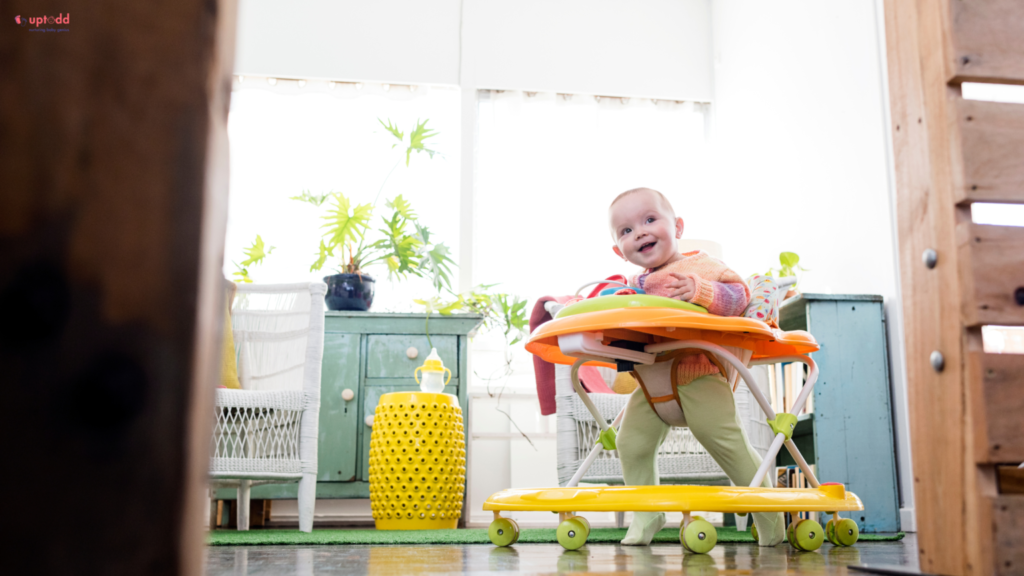
Helping your baby walk – tips to keep in mind
Topic
Helping your baby walk – tips to keep in mind
May start as early as
9 to 15 months
─────────
Related Skills
As soon as our babies start to pull themselves up to stand, we begin to expect one of the best moments to happen – our baby’s first steps. As parents, watching our baby take their first steps is one of the most beautiful and memorable milestones. The anticipation, the excitement, and the joy of seeing those wobbly little steps are unforgettable. And with these little steps, our babies take a big step toward their independence. But alongside the excitement of the milestone, many parents wonder, “How can I best support my baby in learning to walk?” Here are some thoughtful tips to guide you through the journey of helping your baby walk, ensuring it’s as smooth and joyful as possible.
In this blog we will cover:
- What is the right age to walk?
- Exercises to support your baby to walk
- Tips to Encourage your baby to walk
- What you should not do while teaching your baby how to walk?
UNDERSTANDING THE WALKING MILESTONE
First and foremost, it’s important to remember that every baby is different. To support this uniqueness, the walking milestone lies between 9 to 18 months. While many babies begin taking their first steps between 8 to 12 months, others may start a bit later, and that’s perfectly okay. Before walking, babies usually progress through other developmental milestones like rolling over, sitting, crawling, and pulling up to stand. These milestones are important for the baby as they provide great help in building the strength and coordination important for walking.
EXERCISES TO SUPPORT YOUR BABY TO WALK

Focus on Building Core Strength
Before your baby can walk, they need to develop strong core muscles. These muscles, including those in the tummy, back, and legs, are essential for balance and stability. Tummy time is super important for strengthening the muscles that support walking. It helps develop the neck, shoulders, and back, which are all crucial for walking. So don’t stop giving that.
You can help build your baby’s core strength by one more simple activity. Encourage your baby to sit on a small stool with their feet flat on the ground and reach for toys on the floor. In this way, you can work on your little one’s core strength.
Encourage Squatting
When your baby goes up and down, they learn to balance themselves and develop lower body strength needed for walking. Make your baby stand for 5-10 seconds, and then slowly lower their back to a sitting position and repeat again multiple times till your baby is comfortable.
As your baby becomes comfortable and confident in squatting, try some fun activities. Blowing bubbles at different heights can encourage your baby to squat and reach for them, building their lower body strength in this fun process.
You can also play with balls by rolling or tossing them toward your baby and encouraging them to reach down and pick them up. These playful activities make the process enjoyable while helping your baby gain the skills they need to walk confidently.
Encourage Pulling Up to Stand
Learning to pull up to a standing position is a significant milestone. It strengthens your baby’s legs and helps them understand balance. Place toys on a low table or couch to encourage your baby to pull up. You can also guide your baby into a standing position by helping them grasp onto furniture.
Once your baby is standing, encourage them to play while standing by placing toys on a coffee table or sofa. This activity not only motivates them to stand but also helps them develop their balance. Gradually, as your baby gains confidence, they’ll start reaching for toys with one hand, which further strengthens their balance and coordination.
Balancing independently on their feet
This is important to teach your baby balance with little support. To help your little one balance on two feet, try standing behind them and offering a toy in front. This encourages them to turn and reach, which is great practice for developing the balance they’ll need to walk.
You can also place them with their back against a wall or furniture – this way, they start getting used to standing without holding onto something in front.
References from How to Teach Your Baby to Walk
USEFUL TIPS TO ENCOURAGE YOUR BABY TO WALK

Go Barefoot
When you let your baby explore and practice walking without shoes, it helps them feel the ground beneath their feet. This is important for developing balance and coordination. Barefoot walking allows them to use the muscles in their feet and ankles more effectively, strengthening their legs and improving stability. Plus, it gives them a better grip on surfaces, making those early steps a bit easier and more confident.
Promote Cruising
Cruising is when your baby starts moving sideways while holding onto furniture. To encourage this, place your baby’s favourite toys just out of reach along the length of the sofa. Keep on increasing the distance as your baby gets more practice. This motivates them to move sideways, shifting their weight from one leg to the other.
As your baby becomes more confident, you can challenge them by placing furniture at a little gap, encouraging them to take small steps between pieces of furniture.
Introduce a Push Walker (Not Traditional Baby Walkers)
Once your baby is cruising confidently, consider introducing a baby push walker to help your baby transition from cruising to walking. Choose a sturdy push walker that moves slowly. Place the push walker near your baby when they’re standing, and let them hold it. Be there to slowly guide your baby using the push walker. With time, gradually reduce the support as your baby becomes more confident in pushing it on their own.
The World Health Organization and the American Academy of Pediatrics recommend avoiding traditional walkers (in which the baby sits inside) as they can cause developmental delays and pose significant safety risks.
To know more about the risks of traditional baby walkers, check our blog (link of Pallavi’s blog)
Practice Independent Walking
As your baby becomes more confident in standing independently, cruising, and using a push walker, it’s time to encourage independent walking. You can encourage independent walking by standing with one of your family members a short distance apart and inviting your baby to walk from one to the other. This can be a fun and rewarding activity for your little one.
References from 9 Activities to Help Your Child Walk Independently
THINGS TO AVOID WHILE TEACHING YOUR BABY HOW TO WALK

Don’t Rush the Process and Avoid Comparisons
Pushing your baby to walk too soon can lead to frustration and may even delay their progress. Instead, look for signs like pulling up to stand, cruising, and independent standing, and encourage these activities. Avoid comparing your baby’s progress to other children’s milestones. Some babies may walk early, while others may take a bit longer, and that’s perfectly normal.
Don’t Forget to Supervise and Praise your baby
Even in a baby-proofed environment, supervision is essential. Your baby is likely to experience some tumbles and falls as they learn to walk, so it’s important to be there to assist and encourage them. Always stay within arm’s reach when your baby is practicing walking to help prevent falls or injuries. And don’t forget to smile and cheer for your little one
Avoid holding your baby with their hands
As your baby starts taking those first wobbly steps, try holding their hand at shoulder height or down by their sides to help them walk with your support. Or the best way is to hold them through their torso instead of hands. Babies need hands to balance their body weight. When we hold their hands, they might start to bend forward and walk on their toes instead of their whole foot. By holding your baby through their torso, you’re helping them build the strength and balance they need to walk confidently on their own. This simple adjustment encourages them to engage their own muscles, giving them a better foundation as they practice walking.
References from How to Teach a Baby to Walk – Steps to Help Your Baby Learn to Walk (And What to Avoid)
FINAL WORDS
Helping your baby learn to walk is an exciting journey, filled with those heartwarming little victories and, of course, a lot of patience. With just a little bit of knowledge and some simple exercises, we can help our little ones walk. Remember to cheer on every tiny step they take, and don’t forget to shower them with encouragement. Every child is unique, so don’t rush, take your time, enjoy the process, and cherish these special moments as your little one begins taking their first independent steps. Every milestone is important so help your baby by performing small activities to support physical development and capture those milestones into pictures which you can enjoy anytime at any moment in your life.






